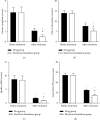Clinical Efficacy Analysis of Biofeedback Electrical Stimulation Combined with Doxycycline in the Treatment of Type IIIA Chronic Prostatitis
- PMID: 36212975
- PMCID: PMC9534622
- DOI: 10.1155/2022/7150204
Clinical Efficacy Analysis of Biofeedback Electrical Stimulation Combined with Doxycycline in the Treatment of Type IIIA Chronic Prostatitis
Retraction in
-
Retracted: Clinical Efficacy Analysis of Biofeedback Electrical Stimulation Combined with Doxycycline in the Treatment of Type IIIA Chronic Prostatitis.Evid Based Complement Alternat Med. 2023 Jul 19;2023:9845859. doi: 10.1155/2023/9845859. eCollection 2023. Evid Based Complement Alternat Med. 2023. PMID: 37501867 Free PMC article.
Abstract
Purpose: To analyse the clinical efficacy of biofeedback electrical stimulation combined with doxycycline in the treatment of type IIIA chronic prostatitis.
Methods: Eighty patients who met the diagnostic criteria of type IIIA chronic prostatitis in our hospital between February 2020 and February 2022 were selected and equally divided into the drug group and electrical stimulation group according to the random number table method. The drug group was treated with medication alone for 4 weeks; the electrostimulation group was treated with biofeedback electrostimulation on top of medication for 12 weeks. The expressed prostatic secretious (EPS) routine (lecithin bodies, white blood cells) and the maximum urinary flow rate (Q max) and mean urinary flow rate (Q ave) were measured before and after treatment in both groups, and the National Institutes of Health chronic prostatitis symptom index (NIH-CPSI) was used to score the urinary symptom, pain or discomfort, and quality of life and determine the efficacy of the treatment in both groups.
Results: After treatment, the number of lecithin bodies and white blood cells in EPS improved significantly in both groups compared to before, and both the electrical stimulation group was better than the drug group (P < 0.05). After treatment, the Q max and Q ave were significantly higher in both groups than before, and both the electrical stimulation groups were higher than the drug group (P < 0.05). After treatment, the urinary symptom scores, pain or discomfort scores, quality of life scores, and total NIH-CPSI scores were significantly lower in both groups than before, and all were lower in the electrical stimulation group than in the drug group (P < 0.05). After treatment, the overall efficiency of patients in the electrical stimulation group was significantly higher than that of the drug group (P < 0.05).
Conclusion: Biofeedback electrical stimulation combined with doxycycline in the treatment of type IIIA chronic prostatitis can synergistically improve the patient's inflammation level, urinary dysfunction, relieve pelvic floor tension myalgia, and improve their quality of life, opening up new avenues for the rehabilitation of patients with type IIIA chronic prostatitis.
Copyright © 2022 Xiaoyong Sun et al.
Conflict of interest statement
The authors declare that they have no conflicts of interest.
Figures




Similar articles
-
[Clinical efficacy of biofeedback and electrical stimulation combined with prostate massage in the treatment of chronic prostatitis / chronic pelvic pain syndrome].Zhonghua Nan Ke Xue. 2020 Nov;26(11):996-999. Zhonghua Nan Ke Xue. 2020. PMID: 34898069 Clinical Trial. Chinese.
-
[Efficacy of biofeedback and electrical stimulation therapy combined with Sabale capsules for chronic prostatitis / chronic pelvic pain syndrome].Zhonghua Nan Ke Xue. 2022 Jan;28(1):43-47. Zhonghua Nan Ke Xue. 2022. PMID: 37459077 Chinese.
-
[Combination therapy of biofeedback with electrical stimulation for chronic prostatitis/chronic pelvic pain syndrome].Zhonghua Nan Ke Xue. 2011 Jul;17(7):611-4. Zhonghua Nan Ke Xue. 2011. PMID: 21823343 Clinical Trial. Chinese.
-
[A Japanese version of the National Institutes of Health Chronic Prostatitis Symptom Index (NIH-CPSI, Okayama version) and the clinical evaluation of cernitin pollen extract for chronic non-bacterial prostatitis].Nihon Hinyokika Gakkai Zasshi. 2002 May;93(4):539-47. doi: 10.5980/jpnjurol1989.93.539. Nihon Hinyokika Gakkai Zasshi. 2002. PMID: 12056038 Clinical Trial. Japanese.
-
Non-pharmacological interventions for treating chronic prostatitis/chronic pelvic pain syndrome: a Cochrane systematic review.BJU Int. 2019 Aug;124(2):197-208. doi: 10.1111/bju.14492. Epub 2019 Jan 17. BJU Int. 2019. PMID: 30019814
Cited by
-
Retracted: Clinical Efficacy Analysis of Biofeedback Electrical Stimulation Combined with Doxycycline in the Treatment of Type IIIA Chronic Prostatitis.Evid Based Complement Alternat Med. 2023 Jul 19;2023:9845859. doi: 10.1155/2023/9845859. eCollection 2023. Evid Based Complement Alternat Med. 2023. PMID: 37501867 Free PMC article.
-
Revolutionizing ovarian cancer therapy by drug repositioning for accelerated and cost-effective treatments.Front Oncol. 2025 Jan 14;14:1514120. doi: 10.3389/fonc.2024.1514120. eCollection 2024. Front Oncol. 2025. PMID: 39876896 Free PMC article. Review.
References
-
- Gujadhur R., Aning J. Careful assessment key in managing prostatitis. Practitioner . 2015;259:15–19. - PubMed
-
- Tang Q. S., Qu M., Sun W. J., Yang C. Q., Boxin W. L., Zhao J. E. International clinical practice guideline of Chinese medicine anxiety. World Journal of Traditional Chinese Medicine . 2021;7(2):280–286.
Publication types
LinkOut - more resources
Full Text Sources
Miscellaneous

